The Shapeshifting Sands
Today, I get to reveal a booster from the new Jumpstart 2022. I was given a list of all of them to pick from, so I chose a theme near and dear to my heart: Shapeshifters. I'm going to use today's column to walk through the early history of Shapeshifters and then introduce you to the new Jumpstart Booster, including a preview of the new card in it. Sound good?
Copy That
Interestingly, the concept of the Shapeshifter creature type goes all the way back to Alpha, but the word itself doesn't get used as a creature type for a few years. When Richard Garfield made the initial game, he knew that he wanted a couple cards that played into the fantasy trope of shapeshifters. Shapeshifting as a theme can be found in countless mythologies and goes back as far as recorded storytelling. Its fantastical nature meant that it quickly became a staple device in fantasy stories.
The first two Shapeshifters to show up (although, again, they were not creature type Shapeshifter yet) were Clone and Vesuvan Doppelganger. Both could become copies of other creatures. The Clone merely did it once upon entering the battlefield, while the Vesuvan Doppelganger could keep changing. Both cards were very popular and saw a lot of play in early Magic (blue being the strongest color didn't hurt). I personally was enamored with both cards and built numerous decks around them.
Antiquities, Magic's second expansion, was the second set to introduce creatures that change their shape. Unlike Alpha, this was represented through the creature changing something about themselves rather than copying another creature. Primal Clay lets you choose one of three forms when you cast it, Shapeshifter allows you to redistribute its power and toughness, and Urza's Avenger can temporarily lose power and toughness in exchange for gaining abilities. Each of these cards pushed the idea of shapeshifting into new mechanical space. None of these creatures had a creature type because, at the time, artifact creatures didn't have creature types. Shapeshifter is the first time the word "Shapeshifter" appears on a card, though.
Legends takes yet a different mechanical approach to shapeshifting. Both Halfdane and Sentinel can change their power and/or toughness based on copying other creatures. Unlike Clone and Vesuvan Doppelganger, they don't become a copy but use another creature to reset their stats. Neither had the creature type Shapeshifter because legendary creatures only used the creature type Legend at the time and, again, artifact creatures didn't yet have a creature type. Legendary becoming a supertype rather than a creature type on creatures was many years away. I should point out that Halfdane was the first legendary creature to (retroactively) be a Shapeshifter.
A whole year goes by until we see another Shapeshifter. Ice Age has Shyft, which can change its color. Note that it doesn't copy color, it just allows its controller to choose whatever color(s) they wish.
It's interesting to note that the only defining quality of shapeshifting creatures by this time is their ability to change something about themselves. The designers keep experimenting with what changes, though. So far, we've seen shifts in size, abilities, and color, in addition to straight up copying. Shyft isn't a creature type Shapeshifter because it's labeled a Shyft. This was a common occurrence in early Magic where instead of trying to tie creatures into larger categories, quirky creatures were just given their name as a creature type.
The next set with Shapeshifters was Tempest. Unstable Shapeshifter was just a Vesuvan Doppelganger, but one that changed what it was at a different time. The other three cards were pushing into new space.
Escaped Shapeshifter was able to copy elements of other creatures, evergreen keywords, which it could mix and match. Dracoplasm was my first attempt at squishing two creatures together. The rules at the time couldn't handle a lot of the complexities, so it just adopts their combined power and toughness. The original design was much closer to what you would see with Unstable's Grusilda, Monster Masher or Ikoria: Lair of Behemoth's mutate mechanic. It was an idea a bit ahead of its time. Flowstone Sculpture was a creature that could adapt and change over time, but each change was permanent.
Tempest would also be the set where we finally get the creature type Shapeshifter. I'd been a big advocate of the concept, as I wanted to be able to build decks that combined different Shapeshifters, so I pushed to get it consolidated into a single word. Shapeshifter seemed like the most open-ended yet descriptive choice. Flowstone Sculpture doesn't get the Shapeshifter creature type because my years-long goal to get creature types for artifact creatures hadn't paid off yet.
You can see my love for Vesuvan Doppelganger continue as I keep making new riffs on it. Volrath's Shapeshifter is from Stronghold.
Interestingly, Morphling from Urza's Saga began as a reprint of Clone. I'd always adored the card and wanted to bring it back to Standard. For some reason, late in development, after the art was already in, the rules manager at the time informed me that we couldn't reprint Clone due to some weird rules problem with it. (To this day, I never understood what the rules issue was.) We designed the card to match the art, choosing to give the creature a lot of flexibility in what it was. It could change its stats. It could gain abilities. The only thing it didn't do was copy anything, as I was told that was off-limits.
Anthroplasm from Urza's Legacy just grew over time. You could spend mana to put +1/+1 counters on it. While this matches the feel of a Shapeshifter, the ability isn't particularly blue. If we made this card today, it would be a green card.
Volrath was designed to be the main antagonist of the Weatherlight Saga. His shapeshifting was a key part of the story because he disguises himself as part of the crew (as Takara, Starke's daughter) for a bit of the story. This was the first time a Shapeshifter was a major character in the story, and in Nemesis, we finally made him a card.
Looking back at it, it's a little lackluster for what was a major villain at the time. He doesn't copy anything, he just makes himself larger. I assume part of this was due to him being mono-black. Speaking of which, Volrath is the first Shapeshifter to be neither part blue nor an artifact. He wasn't printed as a Shapeshifter, though, as legendary hadn't made the leap to a supertype on creatures yet.
Planeshift's Dralnu is another Shapeshifter that basically changes its size (and can gain flying). It's the first with kicker, but other than that, nothing too extraordinary.
Shifty Doppelganger from Odyssey is a quirky design. It's using shapeshifting flavor to justify what's basically a red effect (playing a card from your hand, giving it haste, and sacrificing it at end of turn). If we were making it today and it was still blue, it would probably have you discard a card to turn this card into a copy of the discarded card until end of turn.
Onslaught's Riptide Shapeshifter is the first time a Shapeshifter is represented mechanically with an element of randomness. It can change shape, but you don't know into what. This ability has since been moved from blue to red. Blue can turn into things from the library as long as it knows what it's becoming. If the change is random, that ability now belongs in red.
Dermoplasm from Legions is playing into a mechanical theme that was starting to show up more often: having the Shapeshifter change by literally becoming a different card. The flavor here was that when you un-morph Dermoplasm, it could be any morph creature from your hand. This was playing in more dangerous territory from a play design standpoint because you could turn into creatures you might not yet have the mana to cast.
Mistform Ultimus wasn't printed with Shapeshifter on its card, but it was the first creature to have all creature types, so I'm listing it here. It would pave the way for the first Shapeshifter-specific keyword. (More on that in a bit.)
Adding creature types is something Shapeshifters can change about themselves (without needing to fully copy another creature). Proteus Machine from Scourge was designed as a card to help connect morph to creature-type strategies. Again, not a Shapeshifter when printed because artifact creatures still couldn't have creature types.
Duplicant is the first Shapeshifter to use its copying ability as a kill card. We were trying to find innovative ways to use the imprint mechanic, and it dawned on us that we could use the opponent's creature to set qualities about the imprinting card. Also of note, we used the introduction of an artifact-themed set, Mirrodin, to start finally giving creature types to artifact creatures. This makes Duplicant the first artifact creature to be printed as a Shapeshifter.
Darksteel's Death-Mask Duplicant finds a different way to use imprint on a Shapeshifter. This time, you get to exile creature cards from your graveyard to permanently gain their (at the time) evergreen abilities.
_____ (the card from Unhinged with no name) finds a silver-border (now acorn) quality to change: its name and flavor text. Also a first, the names and flavor text you can gain have to be from an existing card—not necessarily one on the battlefield, just one that exists in the game. This is the first time a Shapeshifter could potentially copy something that isn't in the game. Greater Morphling was just a parody of Morphling, so it obviously needed the same creature type.
Shape Stealer, from Saviors of Kamigawa, is playing into a popular trope from pop culture where the Shapeshifter becomes the creature that it's fighting. It's also the first Shapeshifter printed with a creature type other than Shapeshifter (Spirit).
We've had Shapeshifters that copy dying creatures and ones that copy elements of things from the graveyard, but Ravnica's Dimir Doppelganger is the first to copy dead creatures straight up.
For Time Spiral, we had a lot of fun taking old cards and redesigning them with mechanical tweaks. Vesuvan Doppelganger is an inspiration yet again, this time for a morph creature that uses un-morphing as its means to copy other creatures. It was part of a rare cycle of morph creatures that hint at older cards.
Planar Chaos was about an alternate-reality look at Magic. The inspiration for a number of these changes were old Shapeshifter cards from above. Aquamorph Entity was a morph take on a card like the original Shapeshifter. Body Double was a blue card using blue-flavored abilities to mimic a staple ability in black: reanimation. Jodah's Avenger was a riff on Urza's Avenger. Primal Plasma was a color-shifted version of Primal Clay. Torchling was a red tweak on Morphling.
We end our Shapeshifter history lesson with Lorwyn. A good place to end, as it's the first time Shapeshifters get a mechanic to themselves. Lorwyn had a strong creature-type theme, and we needed something to act as glue to tie the relevant eight creature types together. The inspiration for that glue was Mistform Ultimus (see above). Having Shapeshifters in the set that counted for every creature type allowed players to mix and match different themes and helped all the creature types hit the as-fan they needed to work in Limited. Creatures with changeling would go on to become a fan favorite and have returned numerous times.
The Shapeshifter of Things to Come
Which brings us to today's Jumpstart Booster. Shapeshifter is a theme that only shows up in a single version. Its booster has one rare and one mythic rare. Every Jumpstart Booster has at least one rare or mythic rare, but there are boosters that have more than one (such as the Shapeshifter Jumpstart Booster). I'm going to walk you through all the cards in it and explain the reasoning behind how the booster was built. The Shapeshifter Jumpstart Booster was built by Corey Bowen, so I talked with him about the reasoning behind the card choices.
Pirated Copy (mythic rare)
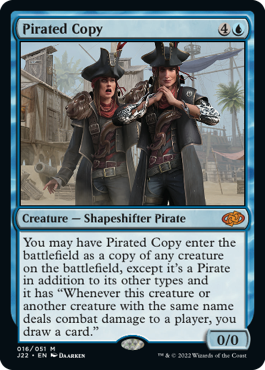
The mythic rare is the new design. Each Jumpstart Booster has one new card. Corey said his goal with this card was to make something simple, as it's Jumpstart 2022, but with a novel twist. Pirated Copy is basically a Clone variant (it enters as a copy of a creature on the battlefield), but it grants all creatures with the same name as the clone what we in R&D nickname the "Curiosity ability" (whenever you deal combat damage to another player, draw a card). Clones copying is pretty normal, but granting abilities to all creatures with the same name is playing in new space. Interestingly, you can copy whatever creature you like, but as you're granting the creature you copy a positive ability, you're encouraged to copy your own creature. Because Jumpstart 2022 cards like to be fun and flavorful, it was made a Shapeshifter Pirate.
Gigantoplasm (rare)

This is the rare in the booster. It's another Clone variant. This version has a mana sink built into it so that in the late game you can use your mana to help break through board stalls.
Mirror Image (uncommon)
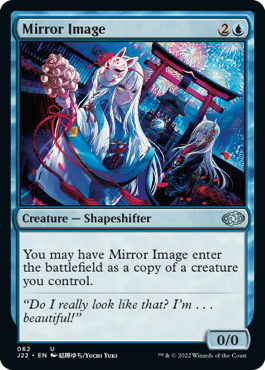
Corey was trying to get a bunch of Clones into this booster, but normally Clones are rare or mythic rare. Mirror Image was one of the few Clone options at uncommon. It's also a little lower on the curve than the other two Clones. Note that one card in each booster has new anime-inspired art, and Mirror Image is the card with this in the Shapeshifter booster.
Bloodline Pretender (uncommon)
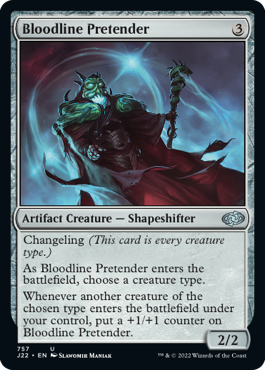
Only so much of the booster could be Clones, so Corey filled out the rest with changeling creatures. Creatures with changeling are Shapeshifters to hit the booster theme and provide the mechanical glue that allows the cards to interact with creature-type themes from other boosters. One of the goals of building a Jumpstart Booster is choosing cards that are open-ended enough to play nicely with cards from other boosters. Because most of the creatures in this booster have changeling, you can use them to choose a creature type from among creatures in the other booster you pick for your Jumpstart deck. This works especially well with other Jumpstart Boosters that have creature-type themes.
Lookout's Dispersal (uncommon)
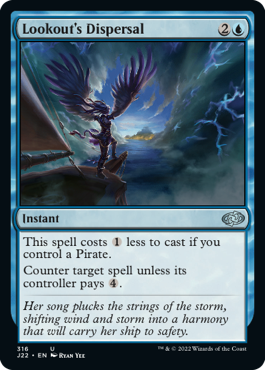
Each Jumpstart Booster has three or four non-creature spells. Some of these need to be answers to your opponent's threats. Lookout's Dispersal is a counterspell with a creature-type theme (in this case Pirates) that plays nicely with changeling.
Heirloom Blade (uncommon)
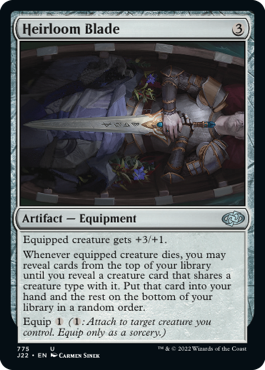
This is the one noncreature spell to buff your own creatures. Heirloom Blade can always be used on your changeling creatures, so you can get any creature when it dies, but if your companion booster has a creature-type theme, you could choose that as well.
Universal Automaton (common)
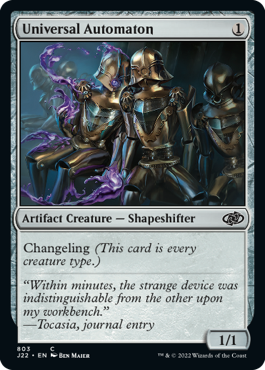
Universal Automaton is a one-drop changeling creature to help with your curve while keeping you on theme. The generic mana cost also helps you cast it on turn one.
Amoeboid Changeling (common)
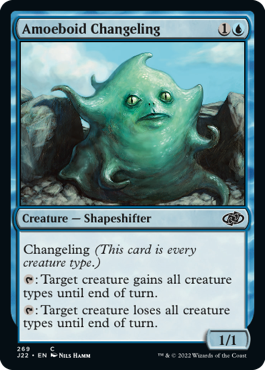
Amoeboid Changeling is both a changeling creature and a card that can manipulate the creature types of your other creatures. This will be especially helpful with creatures from your other booster.
Mistwalker (common)

Mistwalker has changeling, flying, and is a mana sink. Corey said he chose it because it did everything the deck needed.
Littjara Kinseekers (common)
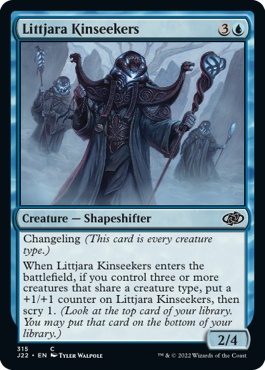
Littjara Kinseekers is a four-drop changeling creature that plays into your deck's theme, most often dropping as a 3/5.
Chilling Trap (common)

Chilling Trap is another answer card that has a reward for having a certain creature type. Corey liked the deck referencing a lot of different creatures. It made it feel more novel and still worked with all the changeling creatures.
Crashing Tide (common)
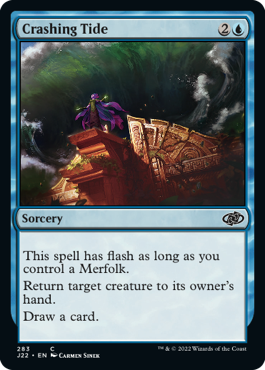
Crashing Tide is the third answer in the booster that has a creature-type rider, this time a Merfolk.
Thriving Isle (common)
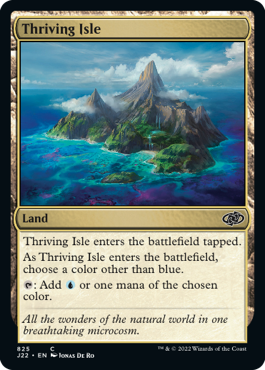
Every Jumpstart Booster has a Thriving land. Shapeshifters has a Thriving Isle, as it's a blue booster. This gives you access to the two colors of your combined boosters.
Islands (7)
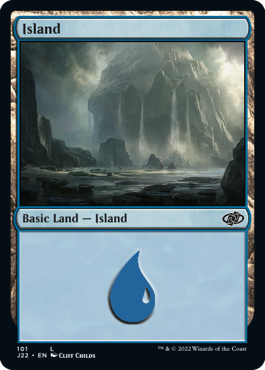






Each booster has seven basic lands in its color.
The goal of all the boosters is to have a novel theme with fun cards that mix well with the various other boosters. Corey explained that there's a science to making a good Jumpstart Booster and that he got a feel for what works best as he built more of them. Corey is very happy with how the Shapeshifter booster turned out and feels it's a perfect theme for Jumpstart as it so naturally blends with other themes. I hope you all get a chance to try it out.
Well, that's all I have for today. I hope you enjoyed my rundown of Shapeshifters throughout Magic's history and my look at the Shapeshifter Jumpstart Booster. As always, I'd love to hear feedback, either on today's column, on Shapeshifters in general, or on Jumpstart 2022. You can email me or contact me through my social media accounts (Twitter, Tumblr, Instagram, and TikTok).
Join me next week when I tell the design story of Urza's melded card.
Until then, may you enjoy playing with Jumpstart 2022.
- Episode 984 The Brothers' War Design
- Episode 983 Magic 30 Las Vegas
- Episode 982 Magic 30 Talk

